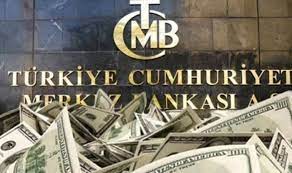In response to the low interest rate policy implemented in the run-up to last year’s general elections and the depletion of reserves due to foreign exchange sales during the ‘controlled exchange rate’ period, the Central Bank turned to domestic and international swap agreements. The Central Bank lent TL to domestic banks and received gold and foreign currency in return, and also made swap deals with other central banks in local currencies. These transactions made the reserves look better than they were.
However, the Central Bank sent a letter to the banks yesterday stating that it would end the TL swap transactions against foreign currency. It currently has swap agreements worth $23.1 billion with the central banks of other countries. Economists emphasize that these agreements should also be terminated for a clean and reassuring balance sheet.
Domestic Swaps Fall from $64.5 Billion
Since 2019, the Central Bank has been trying to keep exchange rates stable by selling foreign currency from its reserves in an environment of unconventional monetary policies, high inflation and rising exchange rates. This approach led to a rapid depletion of foreign exchange reserves.
Instead of implementing a tight monetary policy, the Central Bank decided to ‘make up’ the reserves through domestic and international swap agreements. Because of these swap transactions, economists had to look at the Central Bank’s reserves excluding swaps as the real reserve adequacy could not be understood from total or net reserves.
For domestic swap transactions with banks, the Central Bank was buying foreign currency and gold from banks by giving TL. These transactions had reached quite high levels.
With the new Central Bank management and the return of economic policies to traditional monetary policy, the Central Bank’s swap stock with domestic banks declined from the 2023 peak of $64.5 billion to $144 million as of last week. This is welcomed by both domestic and international market experts.
23. 1 billion dollar swap with other countries
There have been no developments in foreign swap agreements yet.
The Central Bank first signed a $6 billion swap agreement with China, which is renewed every three years, and was last renewed in June 2021. It has swap agreements worth $2 billion with South Korea, $15 billion with Qatar, renewed in December 2021, and $5 billion with the United Arab Emirates, signed in 2022.
Although these swap agreements do not appear as liabilities or assets on the Central Bank’s balance sheet, they are included in the reserve account as dollar equivalents. As of July 12, the swap obligation to the central banks of the country is calculated as 23.1 billion dollars and its TL equivalent is calculated as 756 billion.
The presence of swap transactions in the reserve account, even though they do not appear on the balance sheet, causes controversy about the Central Bank’s reserves.
Economists still calculate the reserve adequacy of the Central Bank with the net reserve account excluding swaps. After the local elections, net reserves excluding swaps have been on a steady upward trend, reaching $23.1 billion as of July 19. Reserves excluding swaps are now positive and the Central Bank continues to accumulate reserves. According to economists, there are no obstacles left to end swap transactions with other central banks.
Clean Balance Sheet Gives Confidence to Investors
Economist Uğur Gürses stated that swap transactions with domestic banks fell to a low level of 144 million dollars and said, “The ‘functional’ mechanism of reserves that have been melted since 2019 and cheap TL lending has come to an end. Country swaps are next. With the closure of these, the ‘make-up’ will end.” Gürses pointed out that warehouse accounts and swap transactions with other countries are different: “Warehouse accounts appear in the balance sheet, both in liabilities and assets. However, swap agreements with countries such as Qatar remain off the balance sheet and are written as reserves. This $23 billion is an off-balance sheet liability.” Gürses reminded that since 2019, swap transactions with the central banks of other countries have started to hide the reserve decreases caused by foreign exchange sales: “Swap transactions were made both with foreign central banks abroad and with domestic banks. The part with domestic banks is over. Now the foreign banks need to be closed so that the Central Bank can present a proper balance sheet picture, a clean balance sheet. Thus, it can offer confidence to both citizens and foreign investors.”
The Central Bank announced that it reviewed international deposit purchase agreements in order to reduce external liabilities within the scope of foreign exchange reserves management and terminated the deposit purchase transaction amounting to USD 5 billion from Saudi Arabia last year. With this transaction, it was stated that external liabilities improved by approximately 7 billion dollars.
Central Bank’s New Swap Auctions
In a letter sent to banks after the Monetary Policy Committee (MPC) meeting, the Central Bank announced that it will start gold and foreign exchange swap auctions against TL. This new swap transaction means that the CBRT will withdraw excess TL liquidity by selling foreign currency and gold on the spot, while buying foreign currency at maturity. Experts say that the CBRT’s FX and gold swap auctions are a step to reduce excess liquidity in the system.
It is stated that the excess liquidity in the market is approximately 180 billion TL. According to experts, the Central Bank’s gold purchases are not considered as imports and are seen as an increase in reserves. Due to the quotas imposed on gold imports, the CBRT will sell gold to banks and buy TL in return, which will reduce TL liquidity and reduce gold import data.
